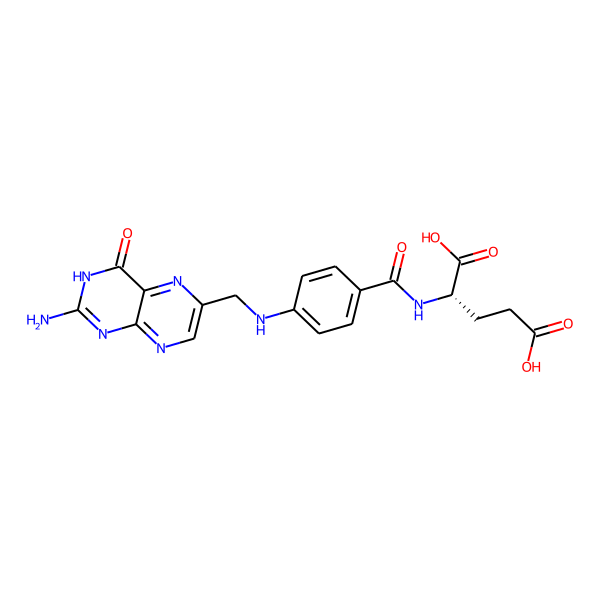Folic acid
Function
DrugBank ID:
Description:
Folic acid, also known as folate or Vitamin B9, is a member of the B vitamin family and an essential cofactor for enzymes involved in DNA and RNA synthesis. More specifically, folic acid is required by the body for the synthesis of purines, pyrimidines, and methionine before incorporation into DNA or protein. Folic acid is particularly important during phases of rapid cell division, such as infancy, pregnancy, and erythropoiesis, and plays a protective factor in the development of cancer. As humans are unable to synthesize folic acid endogenously, diet and supplementation is necessary to prevent deficiencies. For example, folic acid is present in green vegetables, beans, avocado, and some fruits.In order to function within the body, folic acid must first be reduced by the enzyme dihydrofolate reductase (DHFR) into the cofactors dihydrofolate (DHF) and tetrahydrofolate (THF). This important pathway, which is required for de novo synthesis of nucleic acids and amino acids, is disrupted by anti-metabolite therapies such asMethotrexateas they function as DHFR inhibitors to prevent DNA synthesis in rapidly dividing cells, and therefore prevent the formation of DHF and THF. When used in high doses such as for cancer therapy, or in low doses such as for Rheumatoid Arthritis or psoriasis,Methotrexateimpedes the body's ability to create folic acid. This results in a deficiency of coenzymes and a resultant buildup of toxic substances that are responsible for numerous adverse side effects. As a result, supplementation with 1-5mg of folic acid is recommended to prevent deficiency and a number of side effects associated with MTX therapy including mouth ulcers and gastrointestinal irritation.Leucovorin(also known as folinic acid) supplementation is typically used for high-dose MTX regimens for the treatment of cancer. Levoleucovorin and leucovorin are analogs of tetrahydrofolate (THF) and are able to bypass DHFR reduction to act as a cellular replacement for the co-factor THF.There are also several antiepileptic drugs (AEDs) that are associated with reduced serum and red blood cell folate, includingCarbamazepine(CBZ),Phenytoin(PHT), or barbiturates.Folic acid is therefore often provided as supplementation to individuals using these medications, particularly to women of child-bearing age.Inadequate folate levels can result in a number of health concerns including cardiovascular disease, megaloblastic anemias, cognitive deficiencies, and neural tube defects (NTDs). Folic acid is typically supplemented during pregnancy to prevent the development of NTDs and in individuals with alcoholism to prevent the development of neurological disorders, for example. [DrugBank]
Targets:
Folate receptor gamma (Humans); Folate receptor beta (Humans); Folate receptor alpha (Humans) [DrugBank]
Pharmacodynamics:
Folic acid is a water-soluble B-complex vitamin found in foods such as liver, kidney, yeast, and leafy, green vegetables. Also known as folate or Vitamin B9, folic acid is an essential cofactor for enzymes involved in DNA and RNA synthesis. More specifically, folic acid is required by the body for the synthesis of purines, pyrimidines, and methionine before incorporation into DNA or protein. Folic acid is the precursor of tetrahydrofolic acid, which is involved as a cofactor for transformylation reactions in the biosynthesis of purines and thymidylates of nucleic acids. Impairment of thymidylate synthesis in patients with folic acid deficiency is thought to account for the defective deoxyribonucleic acid (DNA) synthesis that leads to megaloblast formation and megaloblastic and macrocytic anemias. Folic acid is particularly important during phases of rapid cell division, such as infancy, pregnancy, and erythropoiesis, and plays a protective factor in the development of cancer. As humans are unable to synthesize folic acid endogenously, diet and supplementation is necessary to prevent deficiencies. In order to function properly within the body, folic acid must first be reduced by the enzyme dihydrofolate reductase (DHFR) into the cofactors dihydrofolate (DHF) and tetrahydrofolate (THF). This important pathway, which is required for de novo synthesis of nucleic acids and amino acids, is disrupted by anti-metabolite therapies such as Methotrexate as they function as DHFR inhibitors to prevent DNA synthesis in rapidly dividing cells, and therefore prevent the formation of DHF and THF. [DrugBank]
Structures
Docking in target protein
Off-target analysis based on ligand similarity (Homo sapiens)
Step 1 - Target prediction for Folic acid: SwissTargetPrediction
Tips: Click on the link to jump to the 'SwissTargetPrediction' webserver. Select the species of 'Homo sapiens', and then paste the SMILES of Folic acid in the SMILES input box.
Step 2 - Blind docking for Folic acid: CB-Dock
Tips: Click on the link to jump to the 'CB-Dock' webserver. Upload the structure file of target predicted by 'SwissTargetPrediction' and the 2D/3D structure file of Folic acid to perform blind docking.
